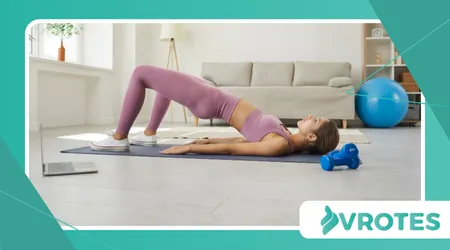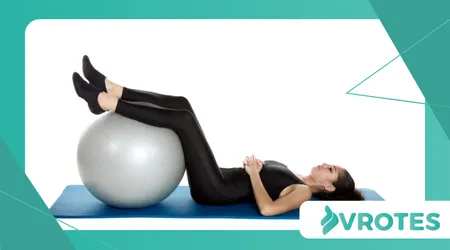Core Stability Moves to Support Pelvic Floor Health

Core stability moves. When we think of a strong core, images of six-packs often come to mind. But the reality is far more intricate.
Anúncios
Your core is a complex network of muscles, including your transversus abdominis, obliques, and multifidus.
These muscles work in concert, providing stability to your spine and torso, and serving as the body’s central powerhouse for movement.
A weak or unbalanced core can lead to a cascade of issues.
In midlife, as hormonal shifts and lifestyle changes occur, this core function becomes even more critical. Think of it as the foundation of a house.
Anúncios
If the foundation is weak, the entire structure is compromised. Similarly, a strong, stable core protects your back and improves your posture.
This stability is the key to maintaining mobility and preventing common aches and pains that can derail your fitness goals.
A robust core also plays a pivotal role in functional fitness.
Simple, everyday activities like carrying groceries, getting out of a chair, or bending over to tie your shoes all depend on a stable trunk.
Neglecting this central support system can make these tasks feel like a chore, limiting your independence and quality of life.
The Overlooked Link: Core Stability and Pelvic Floor Health
The conversation about midlife fitness would be incomplete without discussing the pelvic floor.
This group of muscles at the base of your pelvis supports your bladder, bowel, and uterus.
It’s often talked about in the context of pregnancy, but its health is a lifelong concern for everyone, regardless of gender.
The pelvic floor and the deep core muscles are inextricably linked. They function as a unified team, coordinating to manage intra-abdominal pressure.
When you cough, sneeze, or lift something heavy, your core and pelvic floor muscles contract reflexively to provide support.
Read here: Tai Chi for Stress Reduction and Better Balance
A disconnect in this system can lead to problems like incontinence or pelvic organ prolapse.
Think of your core and pelvic floor as the top and bottom of a sealed drum. For the drum to maintain its integrity, both ends must be strong and working together.
If one is weak or dysfunctional, the pressure inside can’t be properly managed.
This can lead to a breakdown of the system, often manifesting as unexpected and embarrassing symptoms.

Core Stability Moves to Support Pelvic Floor Health
To effectively address this interconnected system, specific exercises are more beneficial than generic ab workouts.
These moves focus on activating and strengthening the deep core muscles and fostering a harmonious relationship with the pelvic floor. It’s about quality of movement, not just quantity.
Incorporating these core stability moves into your routine can create a significant positive impact.
One of the most effective strategies is to focus on breath-work.
Proper breathing, specifically diaphragmatic breathing, is a fundamental component of core and pelvic floor coordination.
It’s not just about filling your lungs with air; it’s about using your diaphragm to create pressure that signals your core and pelvic floor to engage.
This foundational practice is often the first step in rehabilitation and strengthening.
Let’s look at some examples of what to incorporate. The Dead Bug exercise, for instance, is a fantastic way to train your deep core without putting strain on your back.
Read more: Daily Stretching Flow to Combat Menopausal Stiffness
Lying on your back with your legs and arms in the air, you slowly extend one arm and the opposite leg, maintaining a flat back against the floor.
This move demands deliberate control and challenges your core’s ability to stabilize.
An excellent play is the Bird-Dog.
Another excellent move is the Bird-Dog. Starting on your hands and knees, you extend one arm forward and the opposite leg back, creating a straight line from fingertips to heel.
This exercise enhances balance and forces your core to work hard to prevent rotation. Both of these are classic core stability moves that are highly effective.
A third example, the Glute Bridge, is often underestimated. Lying on your back with your knees bent, you lift your hips off the floor, squeezing your glutes.
This exercise not only strengthens the glutes and hamstrings but also actively engages the deep core and pelvic floor muscles.
It’s a foundational movement that builds strength from the ground up, so to speak.
A 2023 study published in the Journal of Physical Therapy Science found that a targeted program focusing on deep abdominal muscle activation significantly improved symptoms of stress urinary incontinence in women over 50.
The study highlighted that focusing on the deep core, rather than just superficial muscles, is the key to lasting improvement.
This finding validates the importance of specific, intentional movements over general workouts.
++ Balancing Omega-6 and Omega-3: Why It Matters in Menopause
Let’s compare the effectiveness of targeted exercises with generic ones. You wouldn’t use a hammer to tighten a screw; you’d use a screwdriver.
Similarly, relying solely on crunches won’t solve a core or pelvic floor issue.
The right tools for the job are specific, targeted core stability moves that address the root cause, not just the symptoms.

Building Your Routine: Practical Steps
Incorporating these exercises doesn’t have to be overwhelming. You can start with just 10 minutes a day, focusing on proper form and breath.
Consistency is far more important than intensity when it comes to these foundational muscles.
For instance, you could begin your workout with five minutes of focused breathing and gentle pelvic tilts, followed by two sets of 10 repetitions each for Dead Bugs and Bird-Dogs.
This simple routine can be a powerful first step toward better core and pelvic floor health.
This type of routine, which focuses on deliberate movement and connection, is the essence of a longevity-focused approach to fitness.
It’s about building a body that supports you for decades to come, not just one that looks good in the mirror today. A strong core is a sign of a body that’s working as a cohesive unit.
It’s also worth noting that approximately 35% of women and 15% of men over the age of 40 experience some form of pelvic floor dysfunction, according to recent data.
This statistic underscores the widespread nature of the issue and the pressing need for proactive solutions like dedicated core stability moves.
Let’s summarize some key points in a table:
| Exercise | Primary Muscles Targeted | Key Benefits |
| Dead Bug | Transversus Abdominis, Obliques | Spine stabilization, controlled movement |
| Bird-Dog | Core, Glutes, Erector Spinae | Balance, posture, back strength |
| Glute Bridge | Glutes, Hamstrings, Pelvic Floor | Pelvic stability, hip mobility |
| Pelvic Tilt | Lower Back, Abdominals | Core activation, spinal articulation |
| Side Plank | Obliques, Transversus Abdominis | Lateral core stability, posture |
A Stronger Foundation for Life
A truly healthy lifestyle isn’t just about what you can see; it’s about what’s happening beneath the surface.
It’s about building a body that is resilient, functional, and pain-free.
Focusing on core stability moves is a critical investment in your future well-being, one that pays dividends in mobility, confidence, and quality of life.
The journey toward a stronger core and healthier pelvic floor is a marathon, not a sprint. It requires patience and a mindful approach.
By understanding the intricate connection between these muscle groups and incorporating targeted exercises, you can empower yourself to live a more active and comfortable life.
The question isn’t whether you have time to focus on your core; it’s whether you can afford not to.
This is one of the most impactful choices you can make for your body’s long-term health.
The importance of these foundational movements cannot be overstated.
A strong, responsive core is a gift you give yourself, ensuring you can tackle life’s physical demands with grace and power.
These core stability moves are the essential building blocks for a healthier, more vibrant you.
Frequently Asked Questions
What exactly is the “core”?
The core isn’t just your visible abdominal muscles. It’s a complex group of deep muscles, including the transverse abdominis, obliques, pelvic floor muscles, and the diaphragm.
They work together to stabilize your spine and torso and are essential for all body movements.
Are women the only ones who need to worry about pelvic floor health?
No. While pelvic floor health is often discussed in relation to women’s health, men also have a pelvic floor.
Dysfunction can affect both sexes, leading to issues like incontinence and sexual dysfunction.
Can I do traditional abdominal exercises, like crunches, to strengthen my core?
While crunches strengthen the superficial abdominal muscles, they can put excessive pressure on the pelvic floor and spine.
Exercises that focus on deep core engagement are more effective for strengthening the deep core and ensuring stability without the risk of overload.
How often should I practice these exercises?
Consistency is more important than intensity. Starting with 10 to 15 minutes a day, three to four times a week, is an excellent starting point.
The focus should be on proper form and the mind-muscle connection, not on the number of repetitions.
Is it normal to feel pain while doing these exercises?
No. Feeling pain can be a sign that something is wrong with your form or that the exercise is not appropriate for you right now.
Always listen to your body. If the pain persists, consult a physical therapist or a qualified fitness professional for an evaluation.
More people are reading: 5 Powerful Pelvic Floor Exercises For Core Strengthening
